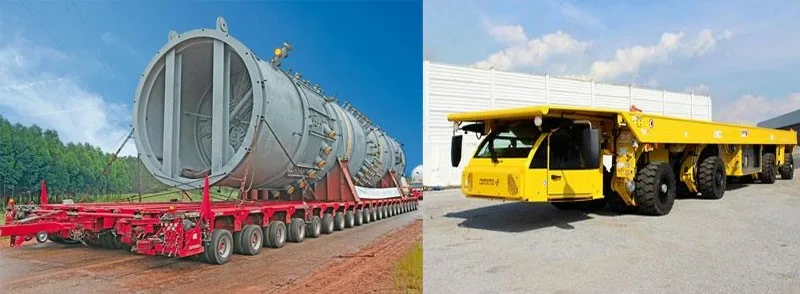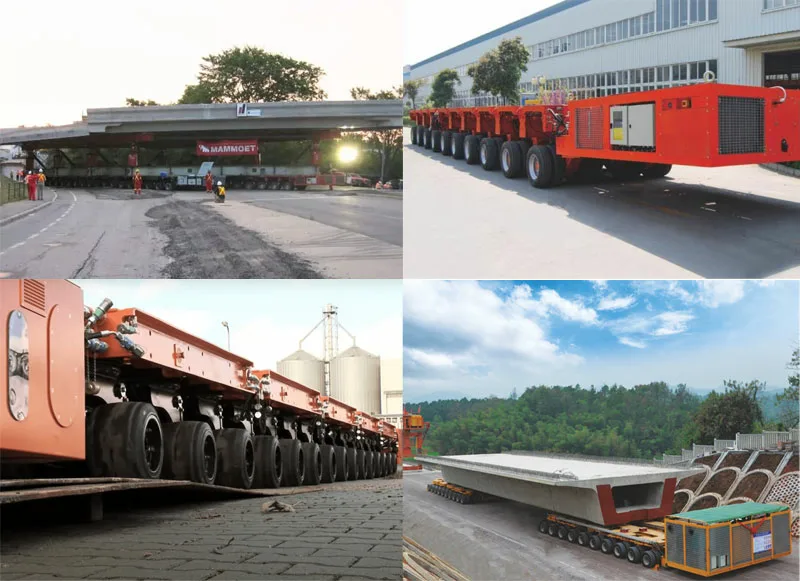Self-Propelled Modular Transporters (SPMTs) are specialized vehicles used in heavy transportation and logistics. They are used to move and transport extremely heavy and oversized loads, such as industrial equipment, bridge sections, construction components etc. They consist of modular units or axles that can be individually controlled and are typically self-powered with engines or motors. The transporters are characterised by their ability to move in multiple directions, including forward, backward, sideways, and diagonally, offering exceptional maneuverability.
The modular nature of SPMTs allows them to be configured to accommodate various load sizes and shapes by adding or removing axle lines. Additionally, they can be interconnected to form a stable platform capable of carrying extremely heavy objects. SPMTs are often equipped with hydraulic or electronic systems for precise control, making them ideal for transporting large and cumbersome equipment, structures, or components within construction sites, industrial facilities, and other contexts where traditional transport methods may be inadequate.

Components of Self-Propelled Modular Transporters (SPMTs)
Self-Propelled Modular Transporters (SPMTs) consist of various components that work together to facilitate the movement of heavy and oversized loads. The primary components of SPMTs include:
- Modules: SPMTs are composed of multiple modular units, often referred to as “axles” or “platforms.” These modules are self-contained and can be connected or disconnected as needed to accommodate different load sizes and weights.
- Axles and Wheels: Each module contains multiple axles, and each axle is equipped with a set of wheels. These wheels are designed to distribute the load weight evenly and provide the necessary traction for movement.
- Hydraulic System: SPMTs are typically powered by hydraulic systems that control the movement of the wheels. The hydraulic system generates the necessary force for propulsion, steering, and lifting operations.
- Power Pack Unit: The power pack unit houses the hydraulic power source, usually a diesel engine or an electric motor. This unit generates hydraulic pressure to operate the system.
- Control System: SPMTs are equipped with advanced control systems that allow operators to control each module independently. The control system enables precise control over speed, direction, and synchronization to ensure the load remains level during transportation.
- Steering Mechanism: Each module has a steering mechanism that enables it to change direction. The steering can be controlled manually by an operator or through the central control system.
- Operator’s Cabin: Some SPMTs have an operator’s cabin where a trained operator can monitor and control the movement of the transporter. The cabin provides visibility for safe navigation and load positioning.
- Load Deck: The load deck is the flat surface on which the heavy load is placed. It is designed to distribute the load weight evenly and often includes securing points or fixtures to safely attach and secure the load during transportation.
- Safety Features: SPMTs are equipped with various safety features, such as sensors, alarms, emergency stop mechanisms, and redundant systems, to ensure the safe transportation of heavy loads and prevent accidents.
- Remote Control: Many SPMTs have remote control capabilities, allowing operators to control the modules from a safe distance for precise maneuvering, especially in complex or hazardous situations.
- Telemetry and Monitoring: Some SPMTs are equipped with telemetry and monitoring systems that provide real-time data on the status of the transporter, including load weight distribution and module synchronization.
Types of Self-Propelled Modular Transporters (SPMTs)
Self-Propelled Modular Transporters (SPMTs) used in construction come in various types, each designed to meet specific load-carrying capacities and operational requirements. Here are some common types of SPMTs used in construction:
1. Conventional SPMTs: These are the standard SPMTs with a modular design, hydraulic axles, and wheels. They are versatile and can be configured to accommodate different load sizes and weights, making them suitable for various construction applications.
2. Electric SPMTs: Electric SPMTs are powered by electric motors rather than diesel engines. They offer reduced emissions, lower noise levels, and are suitable for indoor and environmentally sensitive construction projects.
3. Remote-Controlled SPMTs: Many SPMTs used in construction are equipped with remote control capabilities. This feature allows operators to control the movement of modules from a safe distance, enhancing safety and precision during construction.
4. Self-Loading SPMTs: Some SPMTs are equipped with self-loading mechanisms, which enable them to independently load and unload heavy construction equipment and materials. This is particularly useful for projects where efficient loading and unloading are crucial.
5. Modular and Expandable SPMTs: Certain SPMT models are designed to be modular and expandable, allowing you to adjust the transporter’s size and load-carrying capacity based on specific construction needs. This flexibility is valuable in various construction scenarios.
6. High-Capacity SPMTs: These SPMTs are engineered for handling extremely heavy loads encountered in large-scale construction projects. They have the capacity to transport massive construction equipment, steel structures, and bridge components.
7. Mechanical Steering SPMTs: Mechanical steering SPMTs are known for their reliability and robustness. They use traditional mechanical steering systems and are suitable for straightforward construction transport needs.
8. Mini SPMTs: Mini SPMTs are smaller and more compact versions designed for lighter loads and construction projects with limited space constraints.
The choice of SPMT type for construction projects depends on factors such as the specific load requirements, site conditions, available space, and project timelines.

Features of Self-Propelled Modular Transporters (SPMTs)
Self-propelled modular transporters (SPMTs) are specialized vehicles used for heavy transportation of oversized and heavy objects in various industries. In India, SPMTs are utilized for a wide range of applications, and their features typically include:
1. Self-Propulsion: SPMTs are equipped with their own engines and can move independently, eliminating the need for external towing vehicles.
2. Modular Design: These transporters consist of multiple modules that can be connected or disconnected as needed. This modular design allows for flexibility in terms of payload size and weight capacity.
3. High Load Capacity: SPMTs are designed to carry extremely heavy loads, often ranging from hundreds to thousands of tons, making them suitable for transporting large industrial equipment and machinery.
4. Precision Control: Operators can control each wheel or axle independently, enabling precise manoeuvring and alignment during transportation, even in tight spaces.
5. Remote Operation: Many SPMTs can be operated remotely, which enhances safety and allows for better visibility during complex manoeuvres.
6. Hydraulic Suspension: They often feature a hydraulic suspension system that can adjust the height of the load to accommodate varying road conditions and obstacles.
7. Steerable Wheels: SPMTs have steerable wheels, allowing them to turn at different angles, making it possible to navigate through narrow and challenging pathways.
8. Synchronized Movement: The wheels can be synchronised to move in unison, ensuring that the load remains stable and level during transportation.
9. Safety Systems: SPMTs are equipped with advanced safety features, including sensors and alarms to detect and prevent potential issues during transportation.
10. Transporter Configurations: Various configurations are available, such as 4-, 6-, 8-, or more axle lines, to meet the specific needs of different projects.
11. Adaptability: SPMTs can be used in a wide range of industries, including construction, petrochemical, and energy sectors, for tasks like moving heavy machinery, bridge sections, and large components.
Applications of Self-Propelled Modular Transporters (SPMTs)
Self-Propelled Modular Transporters (SPMTs), have diverse applications in the construction industry.
- Heavy Equipment Transport- used to transport oversized and heavy construction equipment, such as cranes, excavators, bulldozers, and tunnel boring machines, to and within construction sites.
- Bridge Construction- used to transport and position bridge sections, beams, and girders. They can precisely manoeuvre these heavy components into place, making them essential for bridge construction projects.
- Modular Building Construction: used to transport large modular building sections to construction sites, enabling the rapid assembly of structures like modular homes, offices, and healthcare facilities.
- Tunnel Construction- used to transport tunnel boring machines, concrete segments, and other materials needed for tunnel excavation and lining.
- Large-Scale Infrastructure Projects- essential for moving precast concrete elements, such as tunnel segments, beams, and columns, to the construction site for infrastructure projects like tunnels, bridges, and highways.
- Mega-Project Logistics- used in mega-projects like the construction of stadiums, convention centers, and large commercial buildings to move massive steel beams, trusses, and other structural components.
- Mining; used to transport heavy mining equipment, such as haul trucks and crushers, to mining sites and within mining operations.
Conclusion
Self-propelled modular transporters (SPMTs) have emerged as indispensable workhorses in the realm of heavy equipment transport and construction. They have dramatically reduced project timelines, allowing for the rapid replacement of bridges and industrial equipment.
In essence, self-propelled modular transporters have not only simplified logistics and transportation but have also facilitated the development of infrastructure on a grand scale. As construction projects continue to evolve and expand, SPMTs will undoubtedly remain at the forefront, supporting the monumental tasks that shape our infrastructure.
Image Source: everestengg.in, ntclogistics.in, cometto.com, enerpac.com


